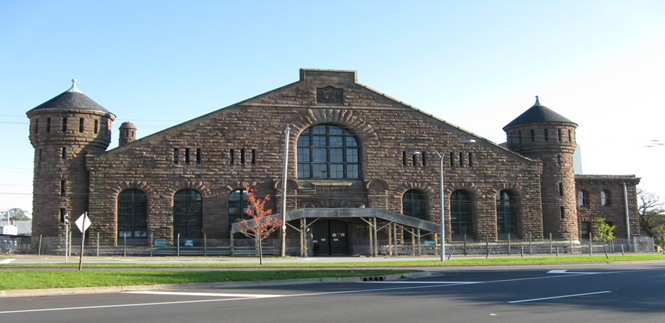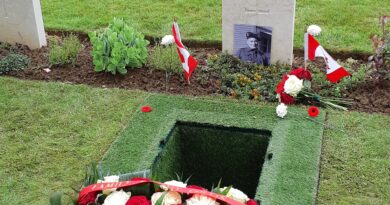Rehabilitation of the Halifax Armouries
One of Halifax’s most prominent landmarks, the historic Halifax Armouries, a.k.a. the North Park Armoury, a National Historic Site and Classified Heritage Building, is getting a major rehabilitation1. The project will see the 120-year old facility benefit from an assigned budget of more than $131 million for two phases over the next five to seven years.
The first phase of the project, beginning early this spring, is valued at about $25 million of which approximately $14 million is for construction. The remainder of the $25 million will include tax costs, design and other professional services. The project will reconstruct the Armouries’ west wall facing the Halifax Common. It will take about two years to complete.
The second phase of the project will include rehabilitation of the remaining exterior and interior elements of the building as well as a fit-up of the armouries’ interior, to meet the operational requirements of the resident units. This phase will begin in 2019 and take about five years to complete. The cost for this phase is estimated at $105 million, of which about $50 million is for construction. The overall cost for both phases of the project of approximately $131 million includes HST charges, as well as design and professional services.
Department of National Defence (DND) Senior Heritage Architect Rosanne Howes was in Halifax on 11 January 2017 to give an overview2 of plans for the Armouries’ future to the Royal United Services Institute of Nova Scotia and guests as part of the Institute’s monthly Distinguished Speaker series.
As noted by RUSI’s master of ceremonies for the event, Commander Colin Darlington, Royal Canadian Navy (retired), not only will the project rehabilitate an important heritage building and military asset, but: “We are talking about a lot of dollars coming to Halifax. We are talking about a lot of work for Nova Scotians, whether it be quarrying the stone or the masons working on the actual project itself. This is a really good news story for Haligonians and for Nova Scotians.”
Contracting authority for the project is Defence Construction Canada under the lead of the Department of National Defence. Public Services and Procurement Canada as the Government of Canada’s center of expertise in building heritage conservation has been called upon to contribute conservation heritage architectural services.
In her presentation entitled “The Hunt for Red Sandstone” Ms Howes described both the history of the building as well as the challenges of making a heritage building serviceable for the modern requirements of Canada’s Army Reserve, principally as the base for the infantry regiment the Princess Louise Fusiliers (PLF), and the Halifax Rifles of the Royal Canadian Armoured Corps, as well as two army cadet corps. Perhaps the most notable aspect in this major project is that the first phase of the work is actually being done to repair damage caused by the 1917 Halifax Explosion almost exactly 100 years ago. Major work will begin this spring to demolish and rebuild the west wall facing the Halifax Commons on North Park Street.
Rosanne noted that a few modifications will be made to accommodate operational needs better, including the widening and increasing the height of the entrance door, and installing new doors. Windows will also be removed and rehabilitated. Most of the distinctive red sandstone will be used, with approximately 20 percent replaced using new stone.
Purposely designed by Dominion Architect Thomas Fuller to withstand massive forces, the building stood the ultimate test on 17 December 1917 as its two-foot thick walls deflected the largest man made, non-nuclear explosion in history. The Halifax Explosion leveled the majority of the buildings in Halifax’s north end. The Armouries, however, rebuffed the blast, surviving with only the loss of windows, some roof damage and some disturbance to the west wall. All of the damage was quickly repaired, including a ‘temporary’ reinforcement to the west wall that has kept it solidly in place for a century.
Ms Howes said that west the wall has a slight forward tilt and needs to be demolished and rebuilt. That part of the project will take almost two years.
The second phase to rehabilitate the remainder of the structure will take about another five years following restoration of the west wall.
“We have had some of the best minds in Canada, if not the world, working on the methodologies for coming up with how we are going to do the repairs and replacement of stone and the rehabilitation of the Armouries” said Ms Howes.
The search for the correct stone literally went world-wide and was filled with CSI-like intrigue, including how the stone was identified in the background of a photo on Kijiji posting selling a used canoe. This led to discovery of the original quarry for the Armoury sandstone at Eel Creek, a tributary of River Philip between Oxford and Pugwash near Port Howe. Stone from many quarries in this area were generically referred to as ‘Pugwash” stone as various quarries shipped through a stone yard there.
Rosanne explained that the old quarry, now flooded, is in the middle of ‘cottage country,’ and the logistics of reopening that specific site are insurmountable. Luckily, a source for the same stone was found in a quarry in a farmer’s field in nearby Beckwith. Testing shows it is in fact from the same seam as the original stone. All the new stone which will be used in the rehabilitation will come from the same source right here in Nova Scotia. The only exception will be a small quantity of stone imported from the Callow Hill stone quarry in England. Because of its higher resistance to water and weather, the Callow Hill stone will be used for window sills.
In recognizing the importance of work to be done to the historic3 building, Lieutenant-Colonel Marcel Boudreau, Canadian Army (retired), former commanding officer of the PLF who once was officer in charge for the Armouries, said, “This is not a building. This is a home”.
He continued, “We trained soldiers when we sent them to war. We welcomed them back. We stood up for emergencies when the city needed it. We’ve celebrated our successes, and we’ve mourned our losses in the building. We’ve hosted rock stars, we’ve heralded royalty.”
Lieutenant-Colonel Boudreau concluded “I look forward to the building standing a lot longer, and continuing to serve the country, the city, the soldiers and the many other people who have served within it.”
Ms Howes concluded her presentation to the crowd, saying, “There are intangible values in landmarks and heritage buildings that you can’t readily put a price on.”
Rosanne alluded to someone who may be thinking about joining the military. She said “If someone walks by the Armouries and sees all that history and sense of respect for all those who have come before us and knows that if they are (potentially) going to give their life for the country, he or she will be honored as well.” That is a huge drawing card for recruiting more people.
“In terms of why we want to invest the money here, is that we do respect those who have gone before us.”
Notes: 1. Rehabilitation: the action or process of making possible a continuing or compatible contemporary use of an historic place, or an individual component, while protecting its heritage value. From: “The Standards and Guidelines for the Conservation of Historic Places in in Canada” http://www.historicplaces.ca/media/18072/81468-parks-s+g-eng-web2.pdf.
2. Her presentation is available at: http://rusi-ns.ca/hunt-red-sandstone-rehabilitation-halifax-north-park-armoury/.
3. Find out more of the history of the Halifax Armouries Armouries at: www.historicplaces.ca/en/rep-reg/place-lieu.aspx?id=13395.
This work is the sole opinion of the authors of the Security Affairs Committee of the Royal United Services Institute of Nova Scotia and does not necessarily represent the views of the Canadian Department of National Defence, the Canadian Armed Forces, the Royal Canadian Mounted Police or the Royal United Services Institute of Nova Scotia. The authors may be contacted by webmail at: RUSI(NS).
Rehabilitation of the Halifax Armouries_170205

